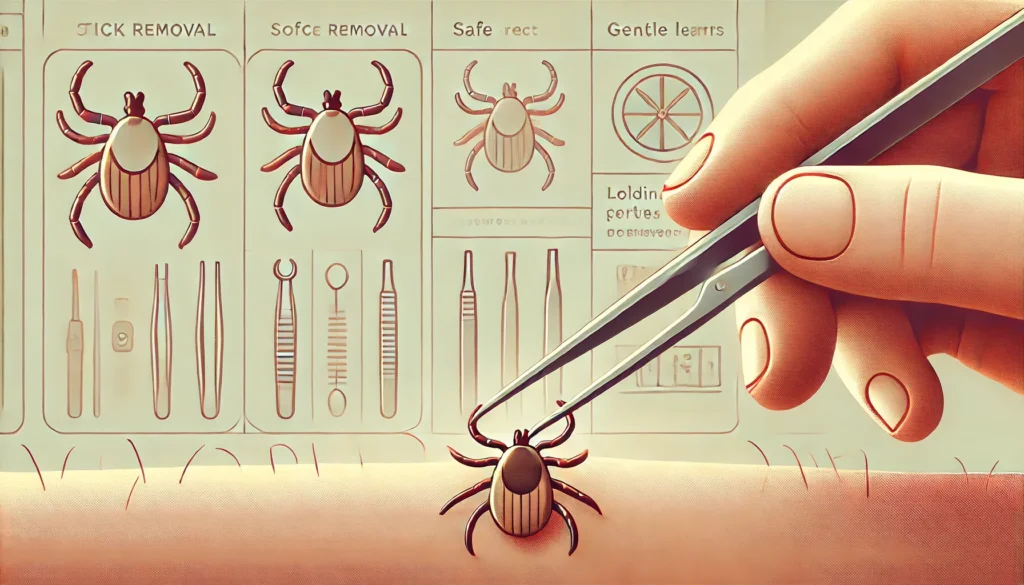Ticks are notorious for attaching themselves to humans and animals, and sometimes when a tick is removed, its head may stay embedded in the skin. While this can be unsettling, it’s important to remain calm and take the right steps to safely remove the tick head and reduce the risk of infection. This guide will walk you through the process step by step.
Why It’s Important to Remove the Tick Head
When a tick head remains lodged in the skin, it can increase the risk of infection or other complications. The tick’s saliva can also trigger allergic reactions in some individuals, and in rare cases, leaving the head embedded can lead to Lyme disease transmission if the tick is infected. Therefore, it’s crucial to remove the head as soon as possible.
Step-by-Step Guide to Remove a Tick Head
1. Clean the Area First
Before attempting to remove the tick head, it’s essential to clean the area around the bite to prevent infection. Use soap and warm water or an antiseptic wipe to gently clean the skin around the tick head. Make sure your hands and any tools you will use are also clean.
- Tip: If you have them, use gloves to avoid direct contact with the tick or the bite area.
2. Use Fine-Tipped Tweezers
To remove the tick head, you will need a pair of fine-tipped tweezers. Standard tweezers may be too large to grasp the head properly, so fine-tipped tweezers are your best option for precise removal.
- Do not use: Your fingers, as this could push the tick head further into the skin.
3. Grasp the Tick Head as Close to the Skin as Possible
Using the tweezers, grab the tick head as close to the surface of the skin as possible. This will give you the most control and reduce the chances of accidentally pushing the head deeper into the skin.
- Important: Avoid squeezing or crushing the tick head, as this may make removal more difficult.
4. Slowly and Steadily Pull Upward
Once you’ve secured the tick head with the tweezers, slowly and steadily pull upward. Be gentle and avoid twisting or jerking, as this can cause the head to break into smaller pieces. Pull in a straight upward motion until the tick head is removed.
- Tip: If part of the head remains lodged in the skin after pulling, don’t panic. Continue to clean the area and watch for signs of infection.
5. Disinfect the Area
After successfully removing the tick head, thoroughly clean the area again using soap and water or an antiseptic solution like hydrogen peroxide or iodine. This helps reduce the risk of infection.
6. Monitor for Signs of Infection
It’s important to keep an eye on the bite area over the next few days for any signs of infection or unusual symptoms. Symptoms of infection might include:
- Redness or swelling that spreads around the bite.
- Pus or fluid drainage from the site.
- Fever, chills, or body aches.
If you notice any of these symptoms, consult a healthcare provider promptly.
What to Do If You Can’t Remove the Tick Head
If you are unable to remove the tick head on your own, or if the area becomes red, swollen, or infected, it’s best to seek medical attention. A healthcare professional can safely remove the tick head and prescribe any necessary treatments, such as antibiotics.
Do’s and Don’ts of Tick Removal
Do:
- Use fine-tipped tweezers for precision.
- Clean the area before and after removal.
- Pull upward in a straight motion to avoid breaking the tick head further.
Don’t:
- Don’t use your fingers to remove the tick head.
- Don’t twist or jerk the tick head while removing it.
- Don’t apply heat, nail polish, or petroleum jelly to the tick head before removal—these methods are ineffective and can increase the risk of infection.
Preventing Future Tick Bites
To avoid future tick bites, here are a few simple precautions:
- Wear long sleeves and pants when walking in wooded or grassy areas.
- Use insect repellent containing DEET on exposed skin.
- Perform tick checks on yourself and your pets after spending time outdoors.
By following these steps, you can safely remove a tick head and reduce the risk of complications from tick bites. If you experience any symptoms after a tick bite or are concerned about Lyme disease, consult a healthcare professional.
FAQs
What happens if you don’t remove a tick’s head?
If a tick head remains embedded in the skin, it can lead to irritation, inflammation, or infection. In some cases, your body may expel the head naturally, but it’s best to try to remove it to prevent complications.
Can a tick head transmit Lyme disease?
While the risk is lower if the tick’s body has been removed, there is still a slight chance of disease transmission if the head remains in the skin. Removing the head reduces the risk.
How do you know if the tick’s head is still in your skin?
If you see small black or brown fragments or feel a hard bump at the site of the bite, the tick head may still be embedded. Using fine-tipped tweezers can help you remove any remaining parts.
When should you see a doctor after a tick bite?
Seek medical attention if the bite area becomes red, swollen, or infected, or if you develop symptoms like fever, joint pain, or a bullseye-shaped rash, which are signs of Lyme disease.
How long does it take for a tick bite to heal?
A tick bite may take several days to heal, especially if there was some irritation or inflammation. However, keeping the area clean and monitoring for infection will help it heal faster.
By following these steps and knowing what to look for, you can safely manage a tick bite and minimize any potential health risks.


